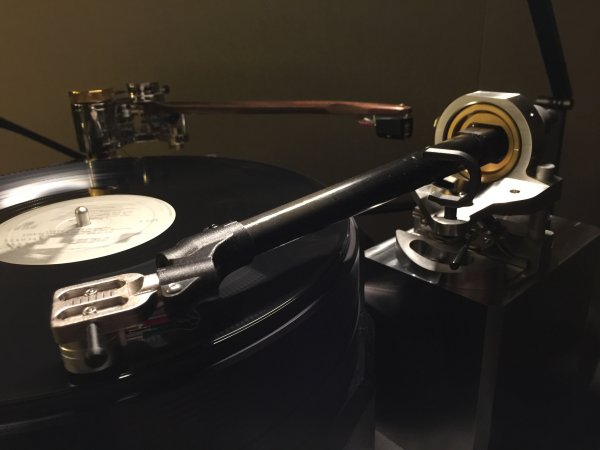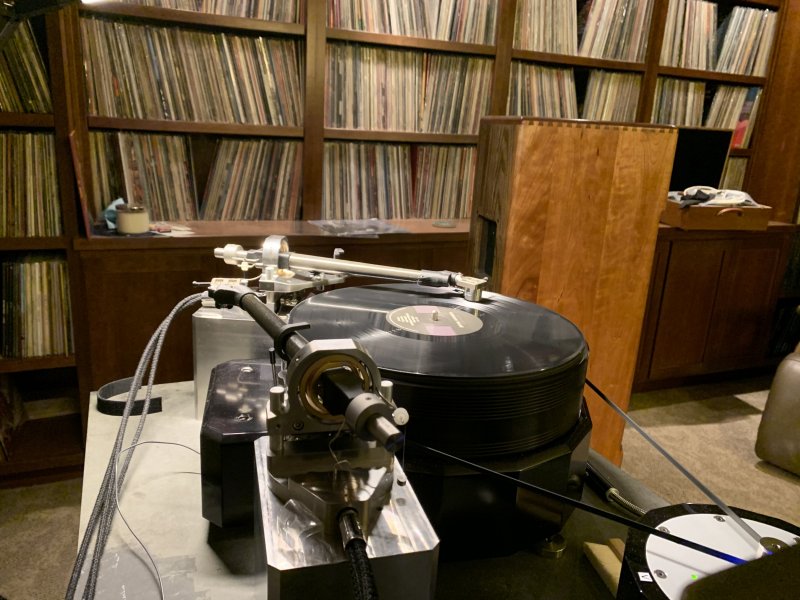INTRODUCTION:
Thought I would share a few initial impressions of Joel Durand's latest and greatest effort: The Tosca. First a couple of caveats: Joel and I are personal friends and I served as one of Joel's "sounding boards" during development; so there is an implicit positive bias. That is balanced by my innate thriftiness (OK, I'm cheap) and reluctance to make changes in my system.
DESIGN:
The tonearm wand is made from a composite material, measuring 10.4" in length. The bearing is gimbaled, a first for Durand whose previous models were unipivot (or constrained unipivot) designs. The aesthetic is industrial chic which I personally find quite attractive and blends well with my Galibier turntable. The arm is impeccably engineered; every part tested and optimized. VTA mechanism is adjustable by loosening screws on the vertical pillars allowing the jack mechanism to raise and lower the arm. The VTA column is also etched for precise, reproducible changes. The cuing mechanism is the best I've ever used...absolutely buttery smooth and accurate. The head-shell is constructed from nickel plated magnesium. There are markings on the head-shell to assist with more precise and reproducible overhang and offset adjustments. Azimuth is adjusted by loosening a screw at the head-shell neck (rather than near the pivot as on prior models). The Tosca also features a detachable head-shell, allowing easier use of multiple cartridges. The cable utilizes a DIN connector.

PRICE:
$14,950 Retail
HOW DOES IT SOUND
I won't bury the lede...this is the best tonearm I've ever heard. I love the sound of my Durand Telos and still consider it one of the finest arms in the world. (I will be using my Telos for mono.) The Tosca is in another, otherworldly league. Of course words are inadequate to describe sound but here a few highlights:
Noise...or lack thereof:
The noise floor is noticeably lower than the already excellent Telos. This results in improved dynamic range and sense of increased output. There is greater illusion of music projecting into the room, more akin to live music. I am able to listen a couple of clicks lower on the volume control. The subtle micro-dynamics of live music are startlingly conveyed, i.e. the ever changing impact of drumsticks on skins and cymbals.
Focus, Sense of Space and Imaging:
One of the first things I noted was the 'focus', instruments and musicians realistically located in space; distinct and natural sounding. Not only is there lack of 'etching', the arm creates a more fleshed out sonic panorama; revealing an increased density of information. With the Tosca, the front to back and side to side location of instruments in space is much more natural and nuanced. In my system, I've listened hundreds of times to "Wrap Your Head Around That" from Lucinda Williams' LP "West" as one of my go to tests of soundstage and imaging. There are multiple instruments closely spaced with musicians coming in and out of the mix.. The Telos is great at untangling the various instruments; the Tosca is next level. I've literally heard things in this track I've never appreciated before.
Timbre:
The bass is flat out killer. Deeper, richer and more textural than I've ever heard, The finger plucking and overtones of Ron's Carters upright bass on Jobim's classic "Insensatez" on the duet record with Rosa Passos is drop dead gorgeous and Rosa's voice is sexy as hell. If you want balls to the wall bass, the Tosca delivers...check out Janelle Monae's "The Way You Make Me Feel" from 'Dirty Computer' or Princes' 12" single "Let's Work"...it's Maxwell tape time. Cymbals shimmer without hardness or artificial sizzle.
CONCLUSION:
I have yet to hear every great tonearm in a familiar system and agree that no one solution is right for every audiophile. I can unequivocally state that this is certainly a contender for 'best' and if you are in the market, the Tosca deserves an audition.
Thought I would share a few initial impressions of Joel Durand's latest and greatest effort: The Tosca. First a couple of caveats: Joel and I are personal friends and I served as one of Joel's "sounding boards" during development; so there is an implicit positive bias. That is balanced by my innate thriftiness (OK, I'm cheap) and reluctance to make changes in my system.
DESIGN:
The tonearm wand is made from a composite material, measuring 10.4" in length. The bearing is gimbaled, a first for Durand whose previous models were unipivot (or constrained unipivot) designs. The aesthetic is industrial chic which I personally find quite attractive and blends well with my Galibier turntable. The arm is impeccably engineered; every part tested and optimized. VTA mechanism is adjustable by loosening screws on the vertical pillars allowing the jack mechanism to raise and lower the arm. The VTA column is also etched for precise, reproducible changes. The cuing mechanism is the best I've ever used...absolutely buttery smooth and accurate. The head-shell is constructed from nickel plated magnesium. There are markings on the head-shell to assist with more precise and reproducible overhang and offset adjustments. Azimuth is adjusted by loosening a screw at the head-shell neck (rather than near the pivot as on prior models). The Tosca also features a detachable head-shell, allowing easier use of multiple cartridges. The cable utilizes a DIN connector.

PRICE:
$14,950 Retail
HOW DOES IT SOUND
I won't bury the lede...this is the best tonearm I've ever heard. I love the sound of my Durand Telos and still consider it one of the finest arms in the world. (I will be using my Telos for mono.) The Tosca is in another, otherworldly league. Of course words are inadequate to describe sound but here a few highlights:
Noise...or lack thereof:
The noise floor is noticeably lower than the already excellent Telos. This results in improved dynamic range and sense of increased output. There is greater illusion of music projecting into the room, more akin to live music. I am able to listen a couple of clicks lower on the volume control. The subtle micro-dynamics of live music are startlingly conveyed, i.e. the ever changing impact of drumsticks on skins and cymbals.
Focus, Sense of Space and Imaging:
One of the first things I noted was the 'focus', instruments and musicians realistically located in space; distinct and natural sounding. Not only is there lack of 'etching', the arm creates a more fleshed out sonic panorama; revealing an increased density of information. With the Tosca, the front to back and side to side location of instruments in space is much more natural and nuanced. In my system, I've listened hundreds of times to "Wrap Your Head Around That" from Lucinda Williams' LP "West" as one of my go to tests of soundstage and imaging. There are multiple instruments closely spaced with musicians coming in and out of the mix.. The Telos is great at untangling the various instruments; the Tosca is next level. I've literally heard things in this track I've never appreciated before.
Timbre:
The bass is flat out killer. Deeper, richer and more textural than I've ever heard, The finger plucking and overtones of Ron's Carters upright bass on Jobim's classic "Insensatez" on the duet record with Rosa Passos is drop dead gorgeous and Rosa's voice is sexy as hell. If you want balls to the wall bass, the Tosca delivers...check out Janelle Monae's "The Way You Make Me Feel" from 'Dirty Computer' or Princes' 12" single "Let's Work"...it's Maxwell tape time. Cymbals shimmer without hardness or artificial sizzle.
CONCLUSION:
I have yet to hear every great tonearm in a familiar system and agree that no one solution is right for every audiophile. I can unequivocally state that this is certainly a contender for 'best' and if you are in the market, the Tosca deserves an audition.





